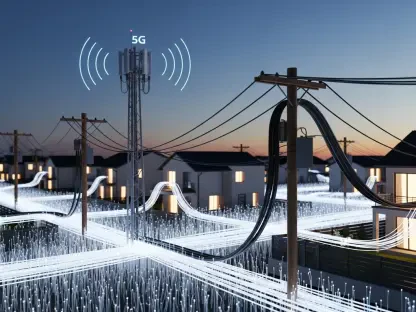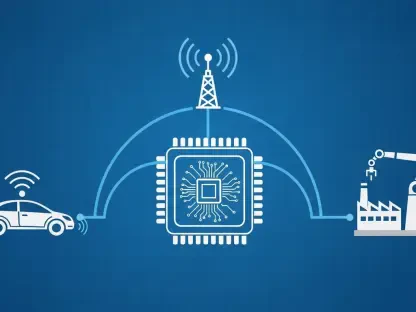In an era where digital connectivity underpins nearly every aspect of daily life, the introduction of cutting-edge wireless technology marks a transformative leap forward for enterprise and campus networks. Imagine a world where networks not only deliver blazing-fast speeds but also intelligently adapt to their surroundings, detect intrusions in real time, and seamlessly integrate with a myriad of smart devices. This is the promise of the latest evolution in wireless standards, heralding a new benchmark with 10Gbps connectivity that goes beyond traditional performance metrics. Developed through collaboration between industry leaders and technical bodies like IEEE, this advancement redefines how connectivity, security, and intelligence converge. It addresses the growing demands of modern digital ecosystems, from supporting augmented reality workflows to enabling energy-efficient building management. This shift represents a holistic approach to networking, setting the stage for smarter, more secure environments across diverse sectors like education, healthcare, and corporate spaces.
Redefining Network Performance with Intelligent Features
The foundation of this new wireless standard lies in its ability to push network performance to unprecedented levels while introducing intelligent capabilities. With support for large-scale 80MHz networking, the technology doubles single-user data rates, ensuring that even high-demand applications run smoothly. Features like coordinated scheduling and spatial reuse optimize bandwidth usage, minimizing interference in crowded environments. Beyond raw speed, low-latency connections are prioritized for critical users, making it ideal for real-time applications such as virtual collaboration tools and immersive augmented reality experiences. This focus on efficiency ensures that enterprise networks can handle the increasing complexity of digital workflows, supporting everything from cloud-based operations to AI-driven analytics. As a result, businesses and institutions can achieve higher productivity without sacrificing reliability, marking a significant departure from earlier standards that often struggled under heavy loads or in dense settings.
Equally impressive is the integration of sensing and Internet of Things (IoT) functionalities into the network framework. This technology enables applications that go far beyond traditional connectivity, such as detecting human presence for energy-efficient building management or using mmWave sensors for continuous health monitoring in medical facilities. These capabilities transform physical spaces into intelligent environments that respond dynamically to user needs and environmental changes. For instance, smart campuses can optimize resource allocation by adjusting lighting and heating based on occupancy, while healthcare providers can monitor patient vital signs without invasive equipment. This convergence of communication and sensing not only enhances operational efficiency but also opens up innovative possibilities for industries looking to leverage connected ecosystems. It’s a clear indication that wireless networks are evolving into multifaceted platforms capable of addressing diverse challenges in the digital age.
Elevating Security in a Connected World
Security stands as a cornerstone of this advanced wireless technology, addressing the escalating concerns of data privacy and unauthorized access in today’s hyper-connected landscape. By incorporating AI-driven mechanisms, the system prevents data leakage through sophisticated scrambling techniques, ensuring that sensitive information remains protected even in high-traffic environments. Real-time intrusion detection further bolsters defenses by monitoring network activity for suspicious behavior, while full-band scanning capabilities help identify hidden threats like unauthorized cameras. These features collectively create a robust shield against modern cybersecurity risks, offering peace of mind to organizations managing sensitive data. As digital ecosystems expand, such proactive measures are essential for maintaining trust and safeguarding user privacy, particularly in sectors where breaches can have severe consequences.
Moreover, the emphasis on secure connectivity extends to creating environments that prioritize user safety and confidentiality. Industry experts have noted that these advancements set a new standard for protecting campus and enterprise networks, especially as reliance on wireless systems grows. The integration of intelligent security protocols ensures that potential vulnerabilities are addressed before they can be exploited, a critical need in settings like educational institutions or corporate offices where multiple users access shared resources daily. This approach not only mitigates risks but also builds a foundation for future innovations in network protection. By embedding security at the core of its design, this technology demonstrates a forward-thinking mindset that aligns with the evolving demands of a digital-first world, ensuring that connectivity does not come at the expense of safety or trust.
Shaping the Future of Wireless Standards
Looking ahead, the impact of this technology on upcoming wireless standards is already becoming evident, blurring the lines between current capabilities and future expectations. While next-generation standards are anticipated to focus on stability and performance under heavy loads, many of these priorities are already addressed through the enhanced features of this system. The overlap suggests that the groundwork laid today could influence how future networks are designed, potentially accelerating the adoption of intelligent and secure connectivity across industries. This proactive integration of advanced functionalities positions the current standard as a pivotal stepping stone, offering a glimpse into a landscape where speed, reliability, and adaptability coexist seamlessly. Enterprises preparing for digital transformation can thus rely on a robust framework that anticipates tomorrow’s challenges.
Reflecting on the strides made, it’s clear that the journey of wireless technology took a significant turn with the rollout of these groundbreaking capabilities. The fusion of high-speed 10Gbps networks with IoT, sensing, and AI-driven security marked a paradigm shift in how connectivity was perceived and utilized. As organizations adapted to these innovations, the focus shifted toward actionable implementation—deploying smarter networks that enhanced user experiences and fortified defenses. Moving forward, stakeholders were encouraged to explore scalable solutions, ensuring that the benefits of intelligent systems reached diverse sectors. The legacy of this advancement was not just in its technical prowess but in its vision of a connected world where efficiency and security were no longer aspirations but tangible realities, paving the way for continued evolution in the digital realm.









